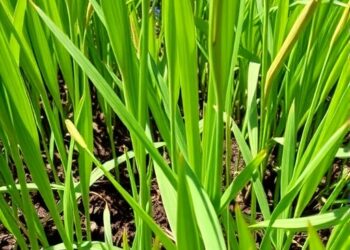The intricate leaf design of Guam’s Serianthes nelsonii tree was used as a model to contribute to the global goal of understanding how a plant leaf functions, and the results were published in the March issue of the journal Nitrogen. This critically endangered legume tree produces an elaborate leaf design that biologists call bi-pinnate, and the thousands of leaflets that contribute to the construction of a single mature leaf provision the tree with the means of crafting highly varied leaf motifs.
The University of Guam study exploited the knowledge that the level of light exposure during leaf construction may profoundly define leaf design.
“We knew prior to this study that leaves of this rare tree are constructed with fewer but larger leaflets if grown in deep shade, but with a greater number of smaller leaflets if grown in direct sunlight,” said author Thomas Marler, retired University of Guam professor. “What we did not know was how the incident light level influenced the actual leaf construction costs.”
Plants are comprised of three vegetative organs, with roots providing anchorage and acquisition of water and essential elements, stems providing mechanical support and translocation of mobile resources, and leaves being the site where plant sugars are manufactured. This process takes the untamed energy from the sun and transforms it into a harnessed energy form. The world’s food supply is made possible by exploiting as building blocks these simple sugars that plant leaves manufacture every day. For this reason, a robust research agenda has unfolded in recent decades with the goal of understanding how this plant organ functions.
“If any organ within the human body were to disappear from the world, nature would continue to thrive,” Marler said. “But if the plant leaf were to disappear, the world’s living organisms would rapidly implode toward starvation.”
The analytical approaches utilized to complete the study quantified the amounts of essential minerals that were required to construct the leaflets, where photosynthesis occurred, versus the supportive tissues, which were designed to place the leaflets where they could maximally exploit the available light. As a group, the minerals that serve as the major plant nutrients were consistently found in greater concentrations in the leaflets, indicating a greater cost associated with building the photosynthetic tissues than the supportive tissues. The influence of incident light during leaf construction exerted a profound influence on leaflet construction costs, but minimal influence on the costs of building the supportive tissues. Leaves that were built under high light conditions required more construction materials than leaves that were built under shaded conditions.
The amount of carbon found in a plant organ provides a proxy for the volume of food that was exploited to build that organ. The University of Guam study revealed that more carbon was required to construct the leaflets than the supportive tissue, more carbon was required to construct a leaf in full sun than a shaded leaf, and the ratio of carbon found in the leaflets versus the supportive tissues did not change in response to incident light load during construction.
The results provide crucial information that informs conservation decisions for this critically endangered tree. For example, the forest soils where the natural trees grow are nutrient-deficient, and these deficiencies may thwart the attempts of conservationists to nurture healthy saplings in the natural settings. One approach for mitigating that nutrient stress would be to provide an appropriate level of shade, since more soil-derived nutrients are required to construct full sun leaves.
The University of Guam study adds to a growing body of research on how light influences Serianthes nelsonii leaf function. Earlier studies revealed that changes in leaflet anatomy were beneficial for exploiting a wide range of incoming light load (leaflet changes) and that rapid leaflet movement provided a means of avoiding high light stress (leaflet movement).




